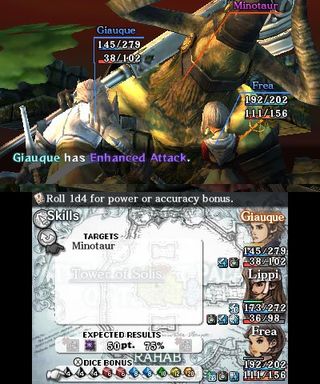GamesRadar+ Verdict
Pros
- +
Fanciful visuals and settings
- +
Great soundtrack
- +
Extensive loot system
Cons
- -
Tiresome and repetitive battles
- -
Lack of explanation and directions at critical parts
- -
Lack of animation and voice-overs
Why you can trust GamesRadar+
Japanese director Yasumi Matsuno is best known for his work on big RPG titles like Vagrant Story and Final Fantasy Tactics, so when it was announced that he was working on his first new IP in years, gamers were understandably excited. And when it was revealed that the game would be designed around the concept of a traditional tabletop RPG, gamers were understandably intrigued. It’s quite disheartening, then, to find out that Crimson Shroud is actually one of Matsuno’s weaker titles. Frankly, it’s quite boring.
Traditional tabletop RPGs involve players acting out roles and sitting around a table rolling dice to decide their fate. It’s an interactive social experience, but in video game form, it simply becomes a solitary adventure. Crimson Shroud has no voice-overs, so you’re the one reading through the text-heavy cutscenes, and you’re the one rolling dice to decide how successful certain actions will be. It's one thing for an RPG to emulate the feel of a board game, but it’s another for it to actually succeed in translating that feeling into a video game. The game is not a graceful marriage, and its tabletop-inspired motifs actually hurt it from being a fun roleplaying game.
Crimson Shroud follows three adventurers in their search for the eponymous source of the world’s magic. The game lasts about eight hours, but due to issues with its pacing, progression feels like it takes much longer. Those pacing issues are largely due to an overabundance of back-tracking, where you must return to areas previously visited to find switches and keys to unlock doors. Revisiting past areas also means you might run into enemy encounters, which consist of the same groups of enemies in the same exact spots.
Unfortunately, you’re given no explanation as to where to go or what to look for to advance the story. Halfway through the game, you are bound to go in circles for over an hour trying to solve a particular problem. The game never tells you what you need to do, and introduces a new mechanic it never again bothers to implement.
Crimson Shroud has no shops nor do your characters ever level up. Instead, their strengths and even attacks rely solely on equipment, so battles are necessary for the valuable weapons and items they reward you with. The loot system works as a good substitute for leveling up, but because you’ll always be fighting the same goblin or Minotaur in an effort to get better items, the whole process soon feels repetitive.
Battles also suffer from being too drawn-out, simply because of how they are designed. Your three characters consist of a mage, a warrior, and an archer, and can use a wide variety of attacks, spells, and support skills. Some attacks require you to roll dice to see how much health you’ll recover, or whether the chosen effect will be successful. But relying on luck, especially during critical moments when you only 3 health points and only one party member alive, only adds frustration to a battle. And while at first it feels good using your stylus or Circle Pad to shake the dice, having to do so each turn to recover MP makes battles more tedious than they should be. Making matters worse, the battle interface makes it difficult to keep track of an enemy’s actions, so you’ll need to pause and read through battle logs in case you missed the quick-scrolling text telling you of an important buff an enemy just used.
Although these references to tabletop RPGs may hurt the battle system, they add a distinct charm to the game’s visual presentation. Characters and enemies all resemble figurines or playing pieces, and though they lack any animation, will occasionally topple over or bounce during battle. Some cutscenes will also give you the choice between different lines of dialogue, while others will throw in a friendly roll of the dice to determine their outcome. These are nice touches and manage to spice up the monotonous task of reading through pages of text. Likewise, its emphatic soundtrack by acclaimed composer Hitoshi Sakimoto is perhaps its saving grace and might be the only thing that keeps you going through some of the lengthier 30-minute battles.

Crimson Shroud is clearly Matsuno’s labor of love, but it’s a shame so many of its features failed in execution and proved more annoying in practice. Its redeeming qualities lie in its presentation, but that barely makes coping with repetitive and tiresome battles any better. If you want to experience something close to what Crimson Shroud should have been, you’re better off playing Vagrant Story and a tabletop RPG at the same time. It’s bound to be far more exciting.
More info
| Genre | Role Playing |
| Description | Crimson Shroud is set 1,000 years in the past in a world without magic in which the story details how magic became commonplace in its world. |
| Platform | "3DS" |
| US censor rating | "Teen" |
| UK censor rating | "" |
| Alternative names | "Guild01" |
| Release date | 1 January 1970 (US), 1 January 1970 (UK) |

After preserving the AI ghost of a fan's late brother, Tekken 8 boss says it might be a glimpse of the future where you don't "need an opponent who is human that has the exact same skill level"

After struggling to make sequel-sized changes, fans think Blizzard might retire the '2' in Overwatch's name based on Season 16 leaks

Valve leads considered making a "mediocre" game before Half-Life to build the team up, but original marketing exec said "if you do that, the company will fail"











